Secure Content Distribution with Access Control Enforcement in Named Data Networking
Abstract
:1. Introduction
- We propose and implement an encryption-based access control mechanism to effectively protect sensitive content in the NDN network using symmetric encryption and identity-based proxy re-encryption (IB-PRE) scheme;
- We design and develop an efficient and secure content distribution scheme to prevent unauthorized consumers from obtaining sensitive and cached contents by setting predefined access time;
- We evaluate and demonstrate through experimental results that our scheme is applicable in NDN without undermining the core NDN architecture, achieves flexible access control, and introduces only a slight overhead on NDN end entities.
2. Background
2.1. A Quick Recap of NDN Architecture
- Interest Packet: generated by the consumers, which brings a hierarchical name related to the target desired content data.
- Data Packet: produced by the content producer, which contains the combination of both the name and the requested content data.
- Consumer: who sends request interest packets to the content producer;
- Data Producer: who produces a data packet based on the consumer’s request and returns it to the consumer through the reverse path of the interest packet;
- Router: who forwards the interest and data packets to and from the content producer and the consumer; caches the returned data packet to satisfy the future requests from the consumer.
2.2. Encryption-Based Access Control and Challenges in NDN
2.3. Proxy Re-Encryption-Based Access Control Schemes in NDN
2.4. Basic Definitions and Notations
2.4.1. Cryptographic Background
- Bilinearity: for all , and ;
- Non-degeneracy: There exists with , in other words, the map does not send all pairs in to the identity in ;
- Computability: There is an efficient algorithm to compute for all .
2.4.2. Symmetric Key Encryption
- Encryption : The encryption algorithm takes a plaintext message m and a symmetric key k as input and generates the output ciphertext C as a result.
- Decryption : The decryption algorithm takes a ciphertext C and a symmetric key k as input and finally decrypt to the original plaintext message m.
2.4.3. Identity-Based Proxy Re-Encryption
- (i)
- Setup (): To generate the scheme parameters, it takes a security parameter α as input and outputs the public and a master secret key ;
- (ii)
- KeyGen (): To extract a decryption key for identity , it takes the public and as input and returns a private key ;
- (iii)
- IBE (): To encrypt the message m, it takes the public , the original message m and identity and generates the ciphertext ;
- (iv)
- ReKeyGen (): In order to generate re-encryption key from to , it takes input and of and produces ;
- (v)
- ReEnc (): To convert the ciphertext of to the ciphertext of , it takes input and and gives as output ciphertext;
- (vi)
- Decrypt (): To decrypt the ciphertext, it takes and as input and finally generates the original message m as the plaintext.
3. System Overview
3.1. Overview of the Proposed Scheme
3.2. System Model
- Content Producer: In our system, original data are produced by the content producer and must be encrypted with the symmetric key. Then the corresponding symmetric key is also encrypted with IB-PRE scheme, which can only access and decrypt by the authenticated consumers.
- Consumers: Consumers request the desired content from the content producer and related decryption key. Moreover, only the consumers who can successfully decrypt the encrypted key with their identities can decrypt the encrypted content.
- Edge Router: Edge router is responsible for the re-encryption of the first layer encrypted key into another ciphertext by using the re-encryption key and delivers to the consumers.
- NDN Router: NDN router forwards the requests from consumers to the content producer. It will also cache the data packet before sending it back to the requested consumer and deliver it to other consumers according to the same request.
3.3. Set-Up and Assumption
3.4. Thread Model
- Type-I adversary. Unauthorized consumer: Consumers who want to access the sensitive content even though he is not eligible to access and try to send the request packets to the network; and
- Type-II adversary. Compromised revoked consumer: Consumers who have already got the decryption key for the content and been revoked, become malicious and attempt to access the old data with the old successfully decrypted key.
4. The Proposed Solution
4.1. Detailed Protocols
- KeyGen: The content producer takes public parameters , master secret key and identity as input and generates a private key .
- IBE: This step is also performed at the content producer side to encrypt the symmetric key k under the content producer’s identity . It takes symmetric key with and public parameters as input and outputs the ciphertext . For some random , it computes and .
- ReKeyGen: When the content producer wants to delegate his or her decryption right to Consumer i, it needs to produce the re-encryption key with the public parameters , its private key and identity of the consumer i as input. First, it selects a random to perform the encryption . It finally outputs the re-encryption key , where . After that, the content producer returns all together by taking the encrypted content , first layer encrypted key , and re-encryption key to the consumer i through the edge router.
- ReEnc: Before forwarding to the consumer i, the edge router first receive the data packet and performs as a proxy. It extracts the re-encryption key part and transforms the first layer encrypted ciphertext to the second layer ciphertext without learning any information about the plaintext of . It takes and as input and generates a re-encrypted ciphertext:. It forwards , to the consumer i.
4.2. Secure Content Distribution Process
4.3. User Revocation
5. System Evaluation
5.1. Security Analysis
5.2. Performance Analysis
5.2.1. Computational Overhead
5.2.2. Communication Overhead
6. Comparisons
7. Related Work
8. Conclusions
Author Contributions
Funding
Institutional Review Board Statement
Informed Consent Statement
Acknowledgments
Conflicts of Interest
Abbreviations
| NDN | Named Data Networking |
| ICN | Information-Centric Networking |
| CCN | Content-centric Networking |
| ES_CD | Efficient Secure Content Distribution |
| PRE | Proxy Re-encryption |
| IBE | Identity-based Encryption |
| IB-PRE | Identity-based Proxy Re-encryption |
| AA | Access Authority |
| TA | Trusted Authority |
| CS | Content Store |
| PIT | Pending Interest Table |
| FIB | Forward Information Base |
| DBDH | Decisional Bilinear Diffie-Hellman |
| id | Identity |
| AES-CBC | Advanced Encryption Standard-Cipher Block Chaining |
| GMP | GNU Multiple Precision Arithmetic |
| PBC | Pairing-based Cryptography |
| VM | Virtual Machine |
| CCA | Chosen-Ciphertext Attack |
| Con | Consumer |
| PNT | Pending Name Table |
| RKT | Re-encryption Key Table |
| FIFO | First In First Out |
References
- Zhang, L.; Estrin, D.; Burke, J.; Jacobson, V.; Thornton, J.D.; Smetters, D.K.; Zhang, B.; Tsudik, G.; Massey, D.; Papadopoulos, C.; et al. Named Data Networking (NDN) Project. NDN Technical Report NDN-0001. Available online: https://named-data.net/techreport/TR001ndn-proj.pdf (accessed on 28 June 2021).
- Zhang, L.; Afanasyev, A.; Burke, J.; Jacobson, V.; Claffy, K.C.; Crowley, P.; Papadopoulos, C.; Wang, L.; Zhang, B. Named data networking. ACM SIGCOMM Comput. Commun. Rev. 2014, 44, 66–73. [Google Scholar] [CrossRef]
- Vasilakos, A.V.; Li, Z.; Simon, G.; You, W. Information centric network: Research challenges and opportunities. J. Netw. Comput. Appl. 2015, 52, 1–10. [Google Scholar] [CrossRef]
- Yu, Y.; Li, Y.; Du, X.; Chen, R.; Yang, B. Content Protection in Named Data Networking: Challenges and Potential Solutions. IEEE Commun. Mag. 2018, 56, 82–87. [Google Scholar] [CrossRef]
- Nour, B.; Khelifi, H.; Hussain, R.; Mastorakis, S.; Moungla, H. Access Control Mechanisms in Named Data Networks: A Comprehensive Survey. ACM Comput. Surv. (CSUR) 2021, 54, 1–35. [Google Scholar] [CrossRef]
- Hamdane, B.; Serhrouchni, A.; Fatmi, S.G.E. Access control enforcement in Named Data Networking. In Proceedings of the 8th International Conference for Internet Technology and Secured Transactions (ICITST-2013), London, UK, 9–12 December 2013. [Google Scholar] [CrossRef]
- Tourani, R.; Misra, S.; Mick, T.; Panwar, G. Security, Privacy, and Access Control in Information-Centric Networking: A Survey. IEEE Commun. Surv. Tutor. 2018, 20, 566–600. [Google Scholar] [CrossRef]
- Chatterjee, T.; Ruj, S.; Bit, S.D. Security Issues in Named Data Networks. Computer 2018, 51, 66–75. [Google Scholar] [CrossRef]
- Mauri, G.; Verticale, G. Up-to-date key retrieval for information centric networking. Comput. Netw. 2017, 112, 1–11. [Google Scholar] [CrossRef] [Green Version]
- Mauri, G.; Verticale, G. Distributing Key Revocation Status in Named Data Networking. In Lecture Notes in Computer Science; Springer: Berlin/Heidelberg, Germany, 2013; pp. 310–313. [Google Scholar] [CrossRef] [Green Version]
- Named Data Networking: NDN Project Overview. Available online: https://named-data.net/project (accessed on 3 February 2021).
- Named Data Networking: Motivation and Details. Available online: https://named-data.net/project/archoverview/ (accessed on 3 February 2021).
- Smetters, D.K.; Golle, P.; Thornton, J. CCNx Access Control Specifications. Technical Report, PARC, Tech. Rep. 2010. Available online: https://www.arl.wustl.edu/~jdd/NDN/CCNX/ccnx/doc/specs/AccessControl/ (accessed on 20 January 2021).
- Gasti, P.; Tsudik, G. Content-Centric and Named-Data Networking Security: The Good, The Bad and The Rest. In Proceedings of the 2018 IEEE International Symposium on Local and Metropolitan Area Networks (LANMAN), Washington, DC, USA, 25–27 June 2018. [Google Scholar] [CrossRef]
- Khelifi, H.; Luo, S.; Nour, B.; Shah, S.C. Security and Privacy Issues in Vehicular Named Data Networks: An Overview. Mob. Inf. Syst. 2018, 2018, 1–11. [Google Scholar] [CrossRef] [Green Version]
- Bertino, E.; Nabeel, M. Securing Named Data Networks: Challenges and the Way Forward. In Proceedings of the 23nd ACM on Symposium on Access Control Models and Technologies, Indianapolis, IN, USA, 13–15 June 2018; pp. 51–59. [Google Scholar] [CrossRef]
- Yu, Y. Public Key Management in Named Data Networking; Tech. Rep. NDN-0029; University California, Los Angeles: Los Angeles, CA, USA, 2015; Available online: https://named-data.net/publications/techreports/ (accessed on 15 January 2021).
- Mambo, M.; Okamoto, E. Proxy cryptosystems: Delegation of the power to decrypt ciphertexts. IEICE Trans. Fundam. Electron. Commun. Comput. Sci. 1997, 80, 54–63. [Google Scholar]
- Blaze, M.; Bleumer, G.; Strauss, M. Divertible protocols and atomic proxy cryptography. In Lecture Notes in Computer Science; Springer: Berlin/Heidelberg, Germany, 1998; pp. 127–144. [Google Scholar] [CrossRef] [Green Version]
- Pareek, G.; Purushothama, B.R. Proxy re-encryption for fine-grained access control: Its applicability, security under stronger notions and performance. J. Inf. Secur. Appl. 2020, 54, 102543. [Google Scholar] [CrossRef]
- Wang, Q.; Li, W.; Qin, Z. Proxy Re-Encryption in Access Control Framework of Information-Centric Networks. IEEE Access 2019, 7, 48417–48429. [Google Scholar] [CrossRef]
- Green, M.; Ateniese, G. Identity-based proxy re-encryption. In Applied Cryptography and Network Security. ACNS 2007. Lecture Notes in Computer Science; Katz, J., Yung, M., Eds.; Springer: Berlin/Heidelberg, Germany, 2007; Volume 4521, pp. 288–306. [Google Scholar]
- Boneh, D.; Franklin, M. Identity-based encryption from the Weil pairing. In Advances in Cryptology — CRYPTO 2001. Lecture Notes in Computer Science; Kilian, J., Ed.; Springer: Berlin/Heidelberg, Germany, 2001; Volume 2139, pp. 213–229. [Google Scholar]
- Silva, R.S.D.; Zorzo, S.D. On the use of proxy re-encryption to control access to sensitive data on information centric networking. In Proceedings of the 2016 International Conference on Information Networking (ICOIN), Kota Kinabalu, Malaysia, 13–15 January 2016. [Google Scholar] [CrossRef]
- Rijmen, V.; Daemen, J. AES Proposal: Rijndael; National Institute of Standards and Technology: Gaithersburg, MD, USA, 1999. Available online: https://csrc.nist.gov/csrc/media/projects/cryptographic-standards-and-guidelines/documents/aes-development/rijndael-ammended.pdf (accessed on 28 June 2021).
- NIST-FIPS. Announcing the Advanced Encryption Standard (AES). In Federal Information Processing Standards Publication; National Institute of Standards and Technology (NIST): Gaithersburg, MD, USA, 2001. [Google Scholar] [CrossRef]
- Granlund, T.; The GMP Development Team. GNU MP: The GNU Multiple Precision Arithmetic Library, 6.2.1 ed. Available online: http://gmplib.org/ (accessed on 20 January 2021).
- Lynn, B.; The PBC Development Team. PBC: The Pairing-Based Cryptography Arithmetic Library, 0.5.14 ed. Available online: https://crypto.stanford.edu/pbc/ (accessed on 20 January 2021).
- NDN. Libraries/NDN Platform. Available online: https://named-data.net/codebase/platform (accessed on 20 January 2021).
- Wood, C.; Uzun, E. Flexible end-to-end content security in CCN. In Proceedings of the 2014 IEEE 11th Consumer Communications and Networking Conference (CCNC), Las Vegas, NV, USA, 10–13 January 2014. [Google Scholar] [CrossRef]
- Suksomboon, K.; Tagami, A.; Basu, A.; Kurihara, J. In-Device Proxy Re-encryption Service for Information-Centric Networking Access Control. In Proceedings of the 2018 IEEE 43rd Conference on Local Computer Networks (LCN), Chicago, IL, USA, 1–4 October 2018. [Google Scholar] [CrossRef]
- He, P.; Wan, Y.; Xia, Q.; Li, S.; Hong, J.; Xue, K. LASA: Lightweight, Auditable and Secure Access Control in ICN with Limitation of Access Times. In Proceedings of the 2018 IEEE International Conference on Communications (ICC), Kansas City, KS, USA, 20–24 May 2018. [Google Scholar] [CrossRef]
- Xia, Q.; He, P.; Xue, K.; Han, J.; Wei, D.S.L.; Yue, H.; Qin, J. TSLS: Time Sensitive, Lightweight and Secure Access Control for Information Centric Networking. In Proceedings of the 2019 IEEE Global Communications Conference (GLOBECOM), Waikoloa, HI, USA, 9–13 December 2019. [Google Scholar] [CrossRef]
- Tseng, Y.F.; Fan, C.I.; Cho, Y.F. An authenticated re-encryption scheme for secure file transfer in named data networks. Int. J. Commun. Syst. 2018, 31, e3571. [Google Scholar] [CrossRef]
- Zhu, Y.; Huang, R.; Tao, Y.; Wang, X. An edge re-encryption-based access control mechanism in NDN. Trans. Emerging Telecommun. Technol. 2019, 30. [Google Scholar] [CrossRef]
- Mannes, E.; Maziero, C.; Lassance, L.; Borges, F. Optimized access control enforcement over encrypted content in information-centric networks. In Proceedings of the 2015 IEEE Symposium on Computers and Communication (ISCC), Larnaca, Cyprus, 6–9 July 2015. [Google Scholar] [CrossRef]
- Guo, X.; Chen, G.; Zhang, M.J.; Ngaboyindekwe, A.; Cao, L.C. Privacy-aware transmission scheme based on homomorphic proxy re-encryption for NDN. Int. J. Secur. Netw. 2018, 13, 58. [Google Scholar] [CrossRef]
- Jacobson, V.; Smetters, D.K.; Thornton, J.D.; Plass, M.F.; Briggs, N.H.; Braynard, R.L. Networking named content. In Proceedings of the 5th International Conference on Emerging Networking Experiments and Technologies, Rome, Italy, 1–4 December 2009. [Google Scholar]
- Fotiou, N.; Polyzos, G.C. Securing Content Sharing over ICN. In Proceedings of the 3rd ACM Conference on Information-Centric Networking, Kyoto, Japan, 26–28 September 2016. [Google Scholar] [CrossRef] [Green Version]
- Chen, T.; Lei, K.; Xu, K. An encryption and probability based access control model for named data networking. In Proceedings of the 2014 IEEE 33rd International Performance Computing and Communications Conference (IPCCC), Austin, TX, USA, 5–7 December 2014. [Google Scholar] [CrossRef]
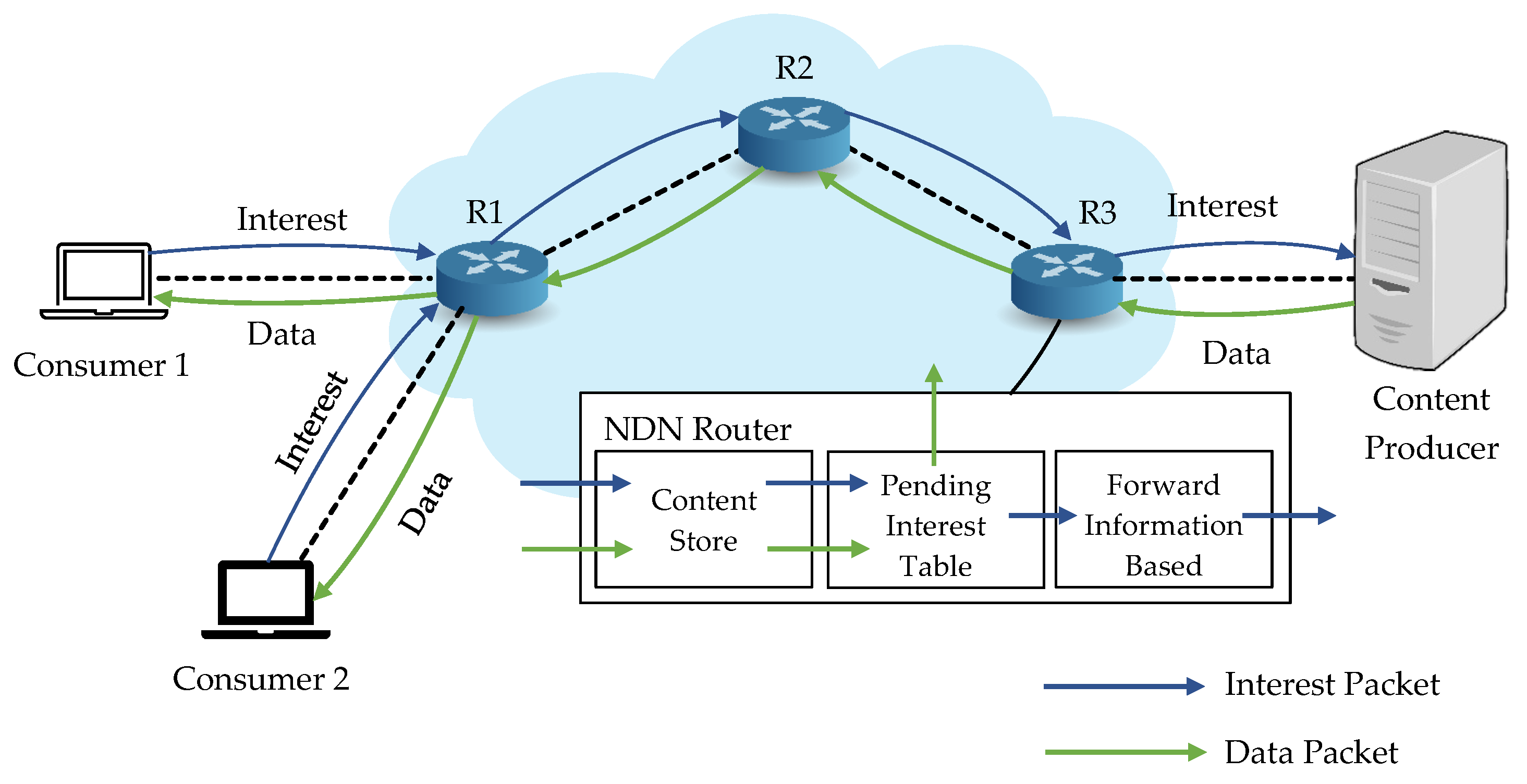

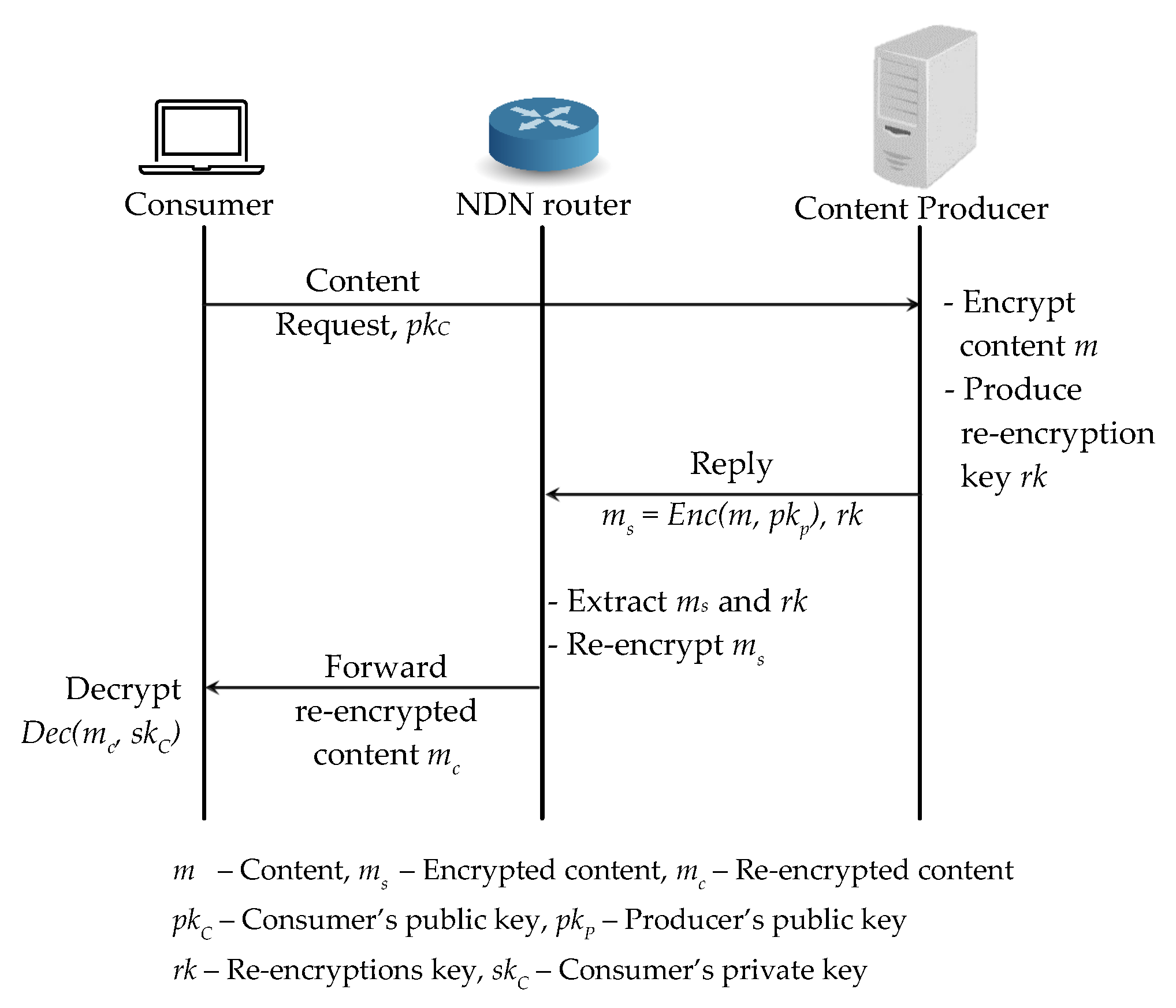

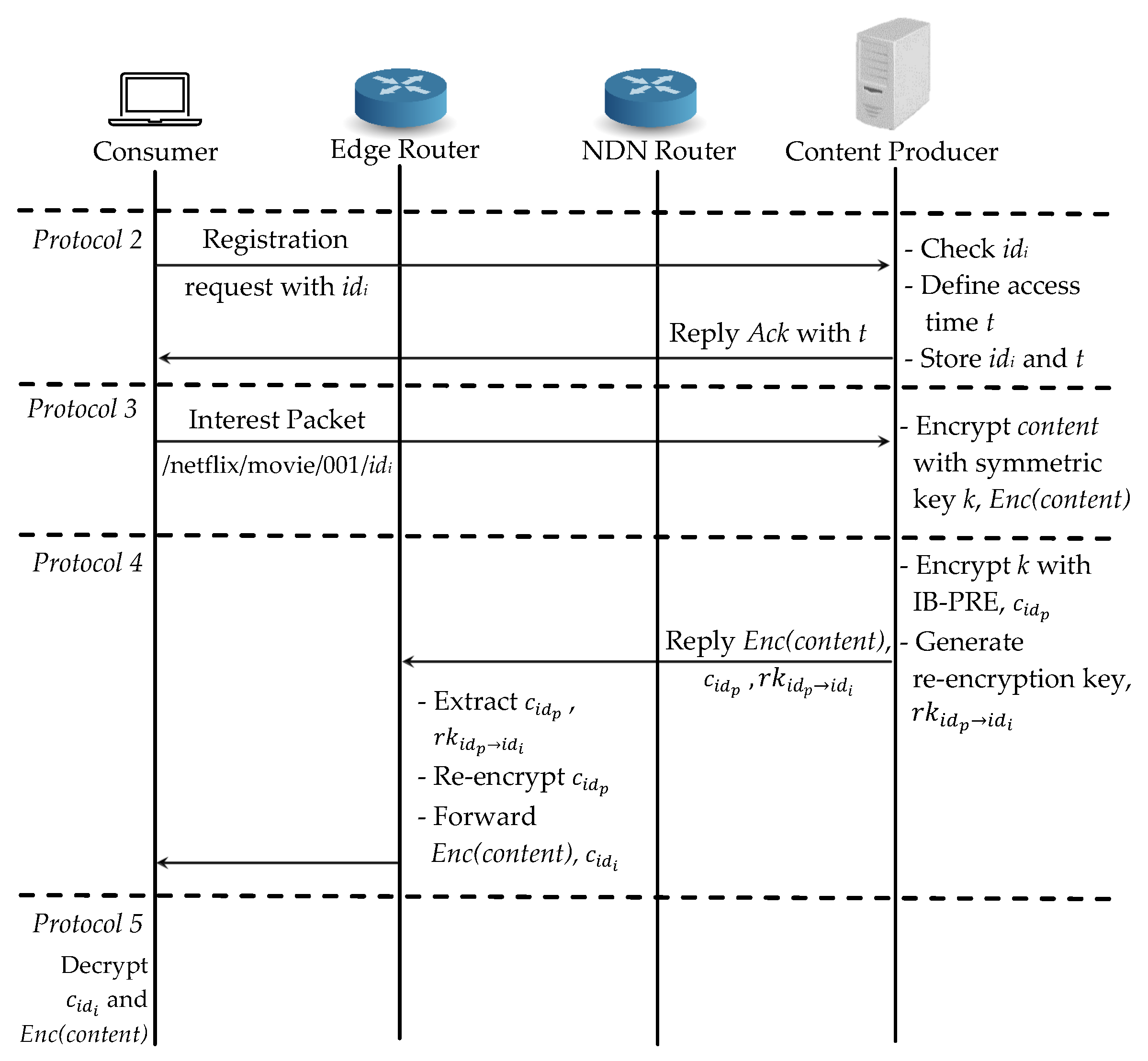

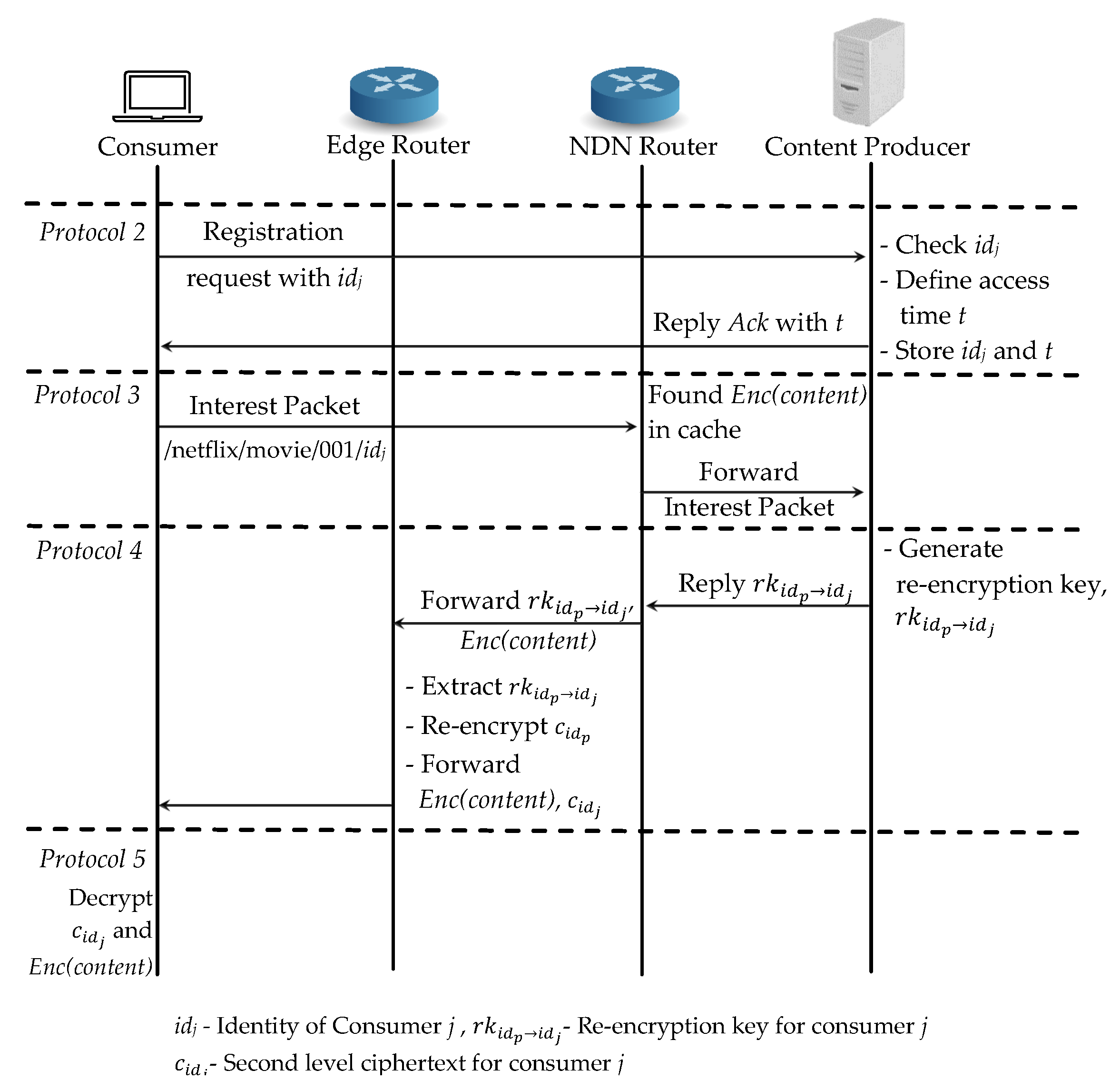
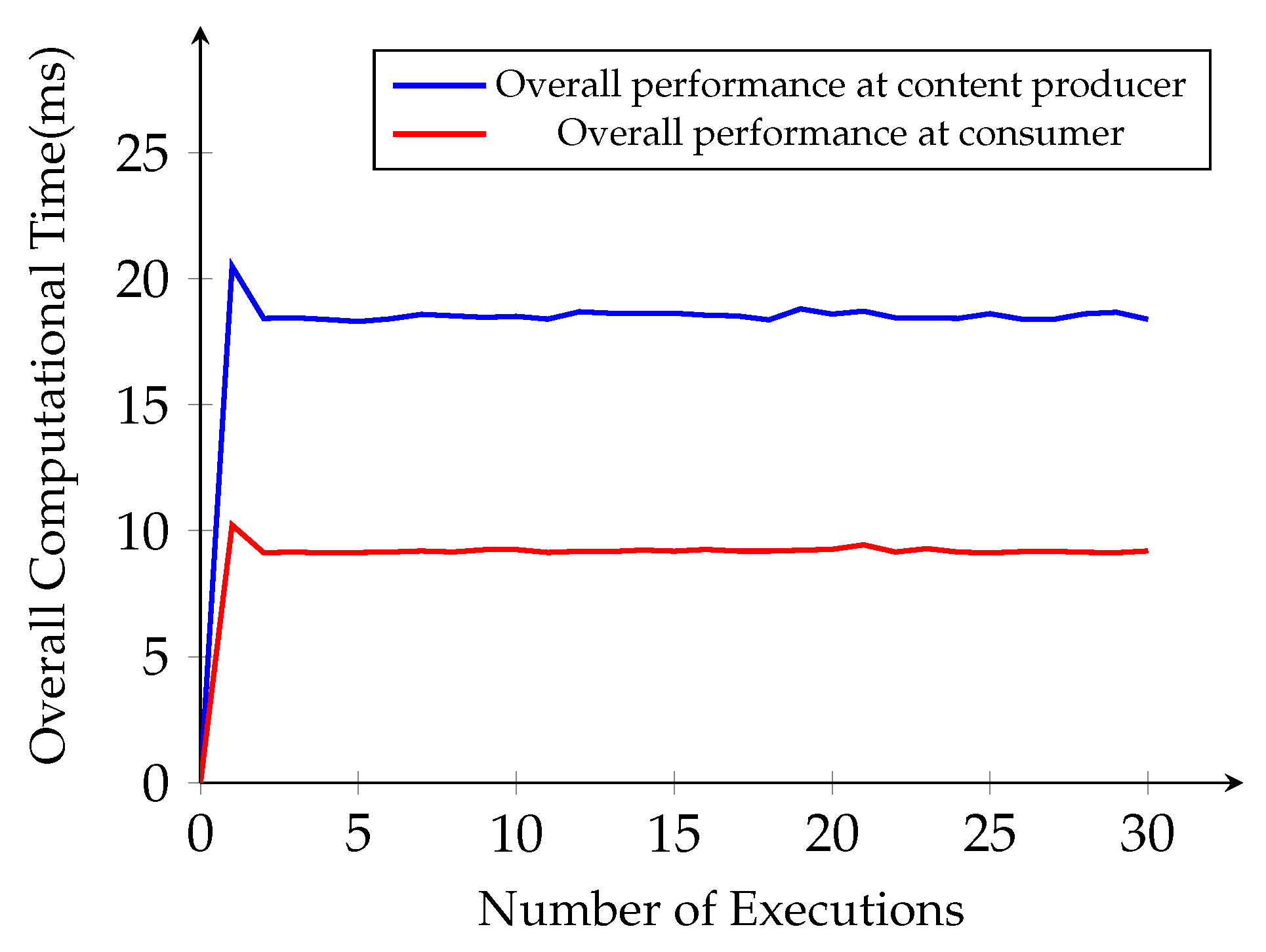

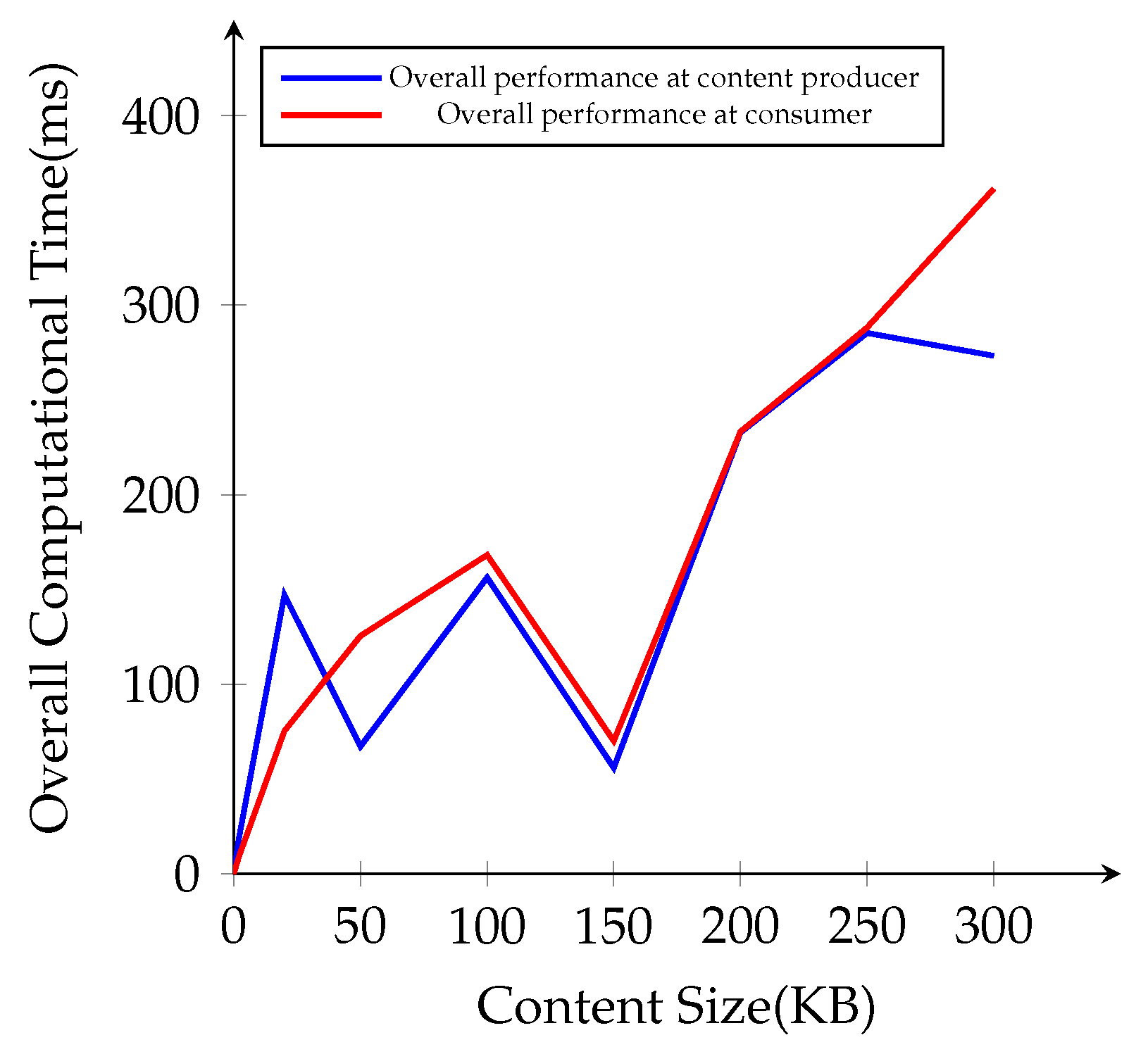

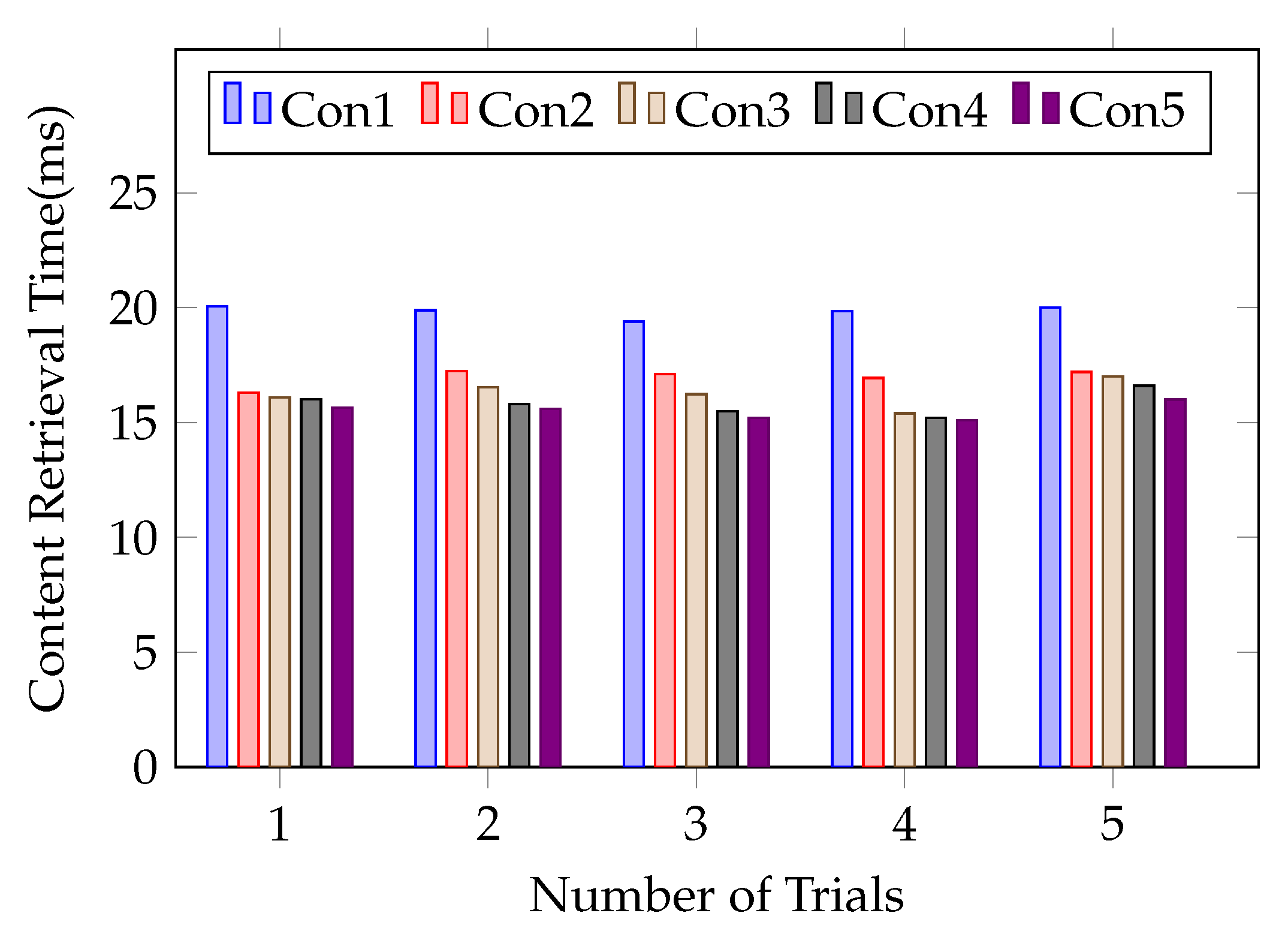

| Notation | Description |
|---|---|
| Master secret key | |
| Public parameters | |
| Private key generator | |
| Identity | |
| Identity of the content producer | |
| Identity of Consumer i | |
| U | Identity and access time tuple |
| Predefined access time for Consumer i | |
| Original content | |
| k | Symmetric key |
| Encrypted content | |
| Secret key | |
| First level ciphertext | |
| Content producer’s secret key | |
| Consumer i’s secret key | |
| Re-encryption key | |
| Second level ciphertext |
| Identity | Expiration Time |
|---|---|
| … | … |
| Operation | Time (ms) |
|---|---|
| AES Encryption | 0.226 |
| Pairing Generation | 1.754 |
| Key Generation | 4.461 |
| IB-PRE Encryption | 3.595 |
| Re-encryption Key Generation | 5.272 |
| Re-encryption | 0.801 |
| Consumer Key Extraction | 2.627 |
| IB-PRE Decryption | 3.171 |
| AES Decryption | 0.199 |
| Scheme | CO | Content Confidentiality | Cache Awareness | Offline CP | AC Approach | Revocation | ||
|---|---|---|---|---|---|---|---|---|
| CP | Con | R | ||||||
| Flexible [30] | H | L | L | Yes | Yes | No | PRE, IBE | Not considered |
| LASA [32] | H | H | L | Yes | Yes | No | Broadcast encryption | Not considered |
| TSLS [33] | H | H | L | Yes | Yes | No | Broadcast encryption | Not considered |
| In-device [31] | H | H | L | Yes | Yes | No | PRE and IBE | Lazy revocation |
| Ours | H | L | L | Yes | Yes | Mostly | Symmetric, IB-PRE | Automatic revocation |
Publisher’s Note: MDPI stays neutral with regard to jurisdictional claims in published maps and institutional affiliations. |
© 2021 by the authors. Licensee MDPI, Basel, Switzerland. This article is an open access article distributed under the terms and conditions of the Creative Commons Attribution (CC BY) license (https://creativecommons.org/licenses/by/4.0/).
Share and Cite
Htet Hlaing, H.; Funamoto, Y.; Mambo, M. Secure Content Distribution with Access Control Enforcement in Named Data Networking. Sensors 2021, 21, 4477. https://doi.org/10.3390/s21134477
Htet Hlaing H, Funamoto Y, Mambo M. Secure Content Distribution with Access Control Enforcement in Named Data Networking. Sensors. 2021; 21(13):4477. https://doi.org/10.3390/s21134477
Chicago/Turabian StyleHtet Hlaing, Htet, Yuki Funamoto, and Masahiro Mambo. 2021. "Secure Content Distribution with Access Control Enforcement in Named Data Networking" Sensors 21, no. 13: 4477. https://doi.org/10.3390/s21134477
APA StyleHtet Hlaing, H., Funamoto, Y., & Mambo, M. (2021). Secure Content Distribution with Access Control Enforcement in Named Data Networking. Sensors, 21(13), 4477. https://doi.org/10.3390/s21134477







